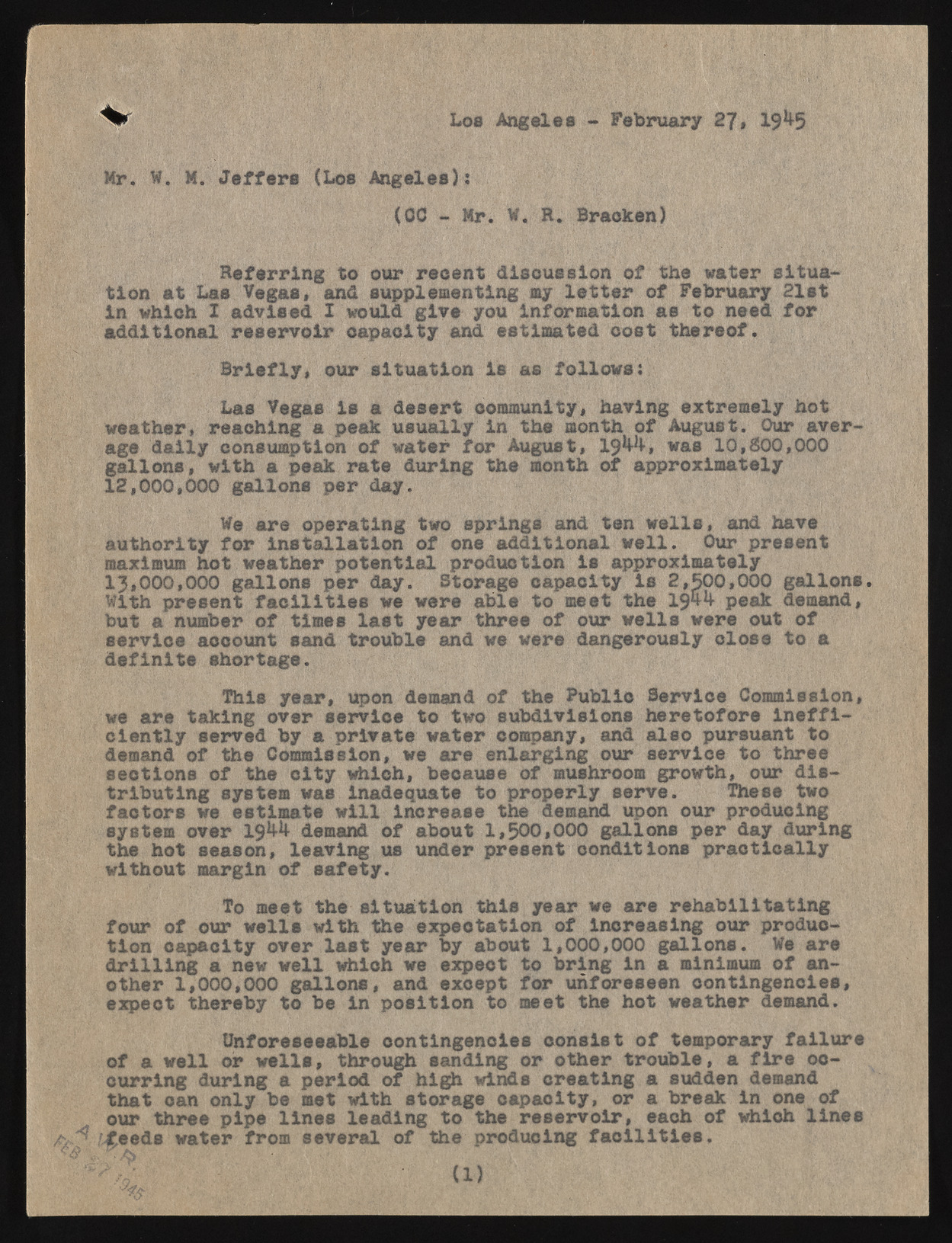Copyright & Fair-use Agreement
UNLV Special Collections provides copies of materials to facilitate private study, scholarship, or research. Material not in the public domain may be used according to fair use of copyrighted materials as defined by copyright law. Please cite us.
Please note that UNLV may not own the copyright to these materials and cannot provide permission to publish or distribute materials when UNLV is not the copyright holder. The user is solely responsible for determining the copyright status of materials and obtaining permission to use material from the copyright holder and for determining whether any permissions relating to any other rights are necessary for the intended use, and for obtaining all required permissions beyond that allowed by fair use.
Read more about our reproduction and use policy.
I agree.Information
Digital ID
Permalink
Details
More Info
Rights
Digital Provenance
Publisher
Transcription
Loa Angeles - February 27» 19^5 Mr. W. M. Jeffers (Loa Angeles): (GC - Mr. V. R. Bracken) Referring to our recent disouaslon tion at Las Vegas, and supplementing ay lette ro f oft hFe eberautaerry s2i1tsutain which Z advised X would give you information as to need for additional reservoir capacity and estimated cost thereof. ? Briefly* our situation is as follows:. Las Vegas is a desert community* having extremely hot awegaet hdeari*l yr ceoancshuimnpgt iao pn eaofk wuastuearl lfyo ri n Autghues tm,o nt19h4 4o,f wAausgu s1t0., £0O0u,r 00a0vergallons* with a peak rate during the month of approximately 12.000. 000 gallons per day. We are operating two springs and ten wells, and have maauxtihmourmit hyo tf owre aitnhsetral ploatteinotni aolf pornoe duacdtdiitoino nisal awpeplrlo.x imOautre lpyresent 13.000. 000 gallons per day. Storage capacity is 2,500,000 gallons. bWuitt h ap rneusmebnetr fofa citliimteis esl awset wyeeraer atbhlree e too f meoeutr wtehle ls1 9w4e4r ep eaokut deomfand, service account sand trouble and we were dangerously dose to a definite ehortage. This year, upon demand of the Public Service Commission, wcei eanrtel y taskeirnvge d obvye r a sperrivviaotee twoa ttewro csoumbpdainvyi,s ioannsd haelrseot poufrosruea nitn eftofidemand of the Commission, we are enlarging our service to three sections of the olty which, because of mushroom growth, our dis ftarcitbourtsi nwge seyssttiemma twea s wiilnla dienqucarteea set o tphre opdeermalnyd sueprvoen. our pTrhoesdeu citnwgo system over 1944 demand of about 1 ,500,000 gallons per day duri ng the hot season, leaving us under present conditions practically without margin of safety. To meet the situation this year we are rehabilitating ftoiuorn cofa paoucri twye lolvse rw ilatsht tyhee are xbpeyc taabtouito n 1,o0f 00i,n0c0r0e asgialnlgo nosu.r prWeo daurcedrilling a new well which we sxpeot to bring in a minimum of anoetxhpeecrt 1t,0he0r0e,0b0y0 tgoa blleo nisn, poasnidt isoxno eptto mfeoer t untfheo rheoste ewne actonhteirn gdeenmcaineds., Unforeseeable contingencies consist of temporary failure cofu rari wnegl ld urori nwge lal sp,e ritohdr ooufg hh isgahn dwiinngd so rc roetahteirn gt roau bslued,d ena dfeirmea ndocotuhra t tchraene opnilpye bel inmeest wlietahd insgt ortao get hec arpeasceirtvyo, iro,r ae abcrhe aokf wihn icohne liofn es /Xeeds water from several of the producing facilities. t lfllli ? (D

